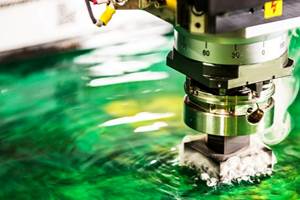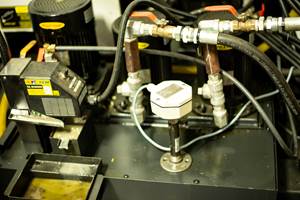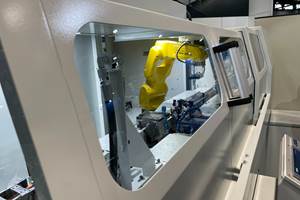The Case For Supplementary Fire Suppression
Systems designed to put out fires inside machine tools can provide a level of protection that external systems such as overhead sprinklers cannot. They cost a small percentage of the investment represented by today’s CNC machines and certainly far less than repairing major damage caused by a fire.
The damage caused by a machine fire can inflict substantial losses on a machine shop. Sometimes the entire facility is a total loss. Left undetected, a machine fire can quickly spread to neighboring equipment or to the building’s structure. Even when the building sprinkler system activates, the machine, and often much more, may be destroyed.
Most milling, turning and grinding equipment is designed to be as safe as possible. However, many of these machines use large amounts of oil-based coolants, making them susceptible to the risk of fire. Excessive heat, programming mistakes, tool failures or other causes can turn a normal CNC operation into a hazardous situation. Fires in electrical discharge machining (EDM) equipment can result from a drop in oil level or other anomaly. In any machining operation with coolant oil and oil vapor present, a single spark can cause a flash fire.
The risk of a fire can be even greater when running lights-out or when an operator leaves a machine unattended. A small fire that is quickly detected and extinguished may cause some minor damage and unscheduled downtime. Left unchecked or undiscovered for even a short period of time, the same fire can destroy equipment, ruin a building and endanger lives.
A supplementary fire suppression system can guard against machine fires and keep them from causing a catastrophe. These systems cost a small percentage of the investment represented by today’s CNC machines and certainly far less than repairing major damage caused by a fire.
Oil-Based Fluids—Needed But Risky
Many serious fires start when an oil-based fluid ignites. So why would anyone use these combustible oil-based fluids? They are often necessary to achieve a quality surface finish, reduce cycle time and improve tool life.
Straight oils, for example, are typically composed entirely of petroleum or mineral oil (sometimes including wetting and pressure additives). They provide excellent lubrication between the cutting tool and workpiece, which improves surface finishes and helps increase tool life. Straight oils are the preferred choice for many drilling, broaching, tapping, grinding and honing operations.
Unfortunately, straight oils are combustible, with a relatively low flash point of about 400° F. Straight oils also dissipate heat poorly, thus increasing the risk of fire. Straight oil vapors can flash into flame in an instant, which partially explains why they are typically restricted to use in low-temperature and low-speed operations.
Flash fires in machines using oil-based fluids require fast action. Yet tight schedules and slim margins have forced many plant managers to run some machines unattended, which greatly increases the danger from undetected fires. However, even when an operator is present, a machine can be completely engulfed by a flash fire in seconds.
Many shop owners expect employees to control the situation using portable extinguishers. This may be an unrealistic expectation. A machine fire can unnerve even the coolest operator. Moreover, any fire large enough to damage a machine can jeopardize worker safety.
Sprinklers May Not Be Enough
Local fire authorities usually require machine shops to install overhead sprinklers, based on National Fire Protection Association (NFPA) standards. Many shops assume that these systems are adequate to protect buildings and machines from a fire. However, while water sprinkler systems do provide reliable fire suppression, they are not designed to protect individual machines. In most cases, a CNC machine would have to be completely engulfed in flames before a sprinkler system activates. The likely result is severe damage or total destruction of the machine and damage to the surrounding area. In addition, collateral water damage from a sprinkler discharge can greatly exceed that caused by the fire itself.
Many shop owners who have recognized the inadequacies of sprinkler systems have begun to invest in supplementary fire suppression systems to protect their CNC and EDM machines. These supplementary systems are not designed to replace code-mandated sprinklers—they are designed to extinguish a fire at its source before it can grow large enough to trigger the overhead sprinkler system.
Supplementary Fire Suppression
Systems
Various types of on-machine fire suppression systems are available, and most function in much the same way. Some type of mechanism within the machine’s enclosure triggers the release of an extinguishing agent when it detects a fire. The cost of these systems varies depending on the complexity of the detection mechanism and control system. The box below discusses the approach taken by Firetrace International LLC, which is designed to provide a simple but reliable system based on pressurized tubing for fire detection and suppression.
Various types of on-machine fire suppression systems are available, and most function in much the same way. Some type of mechanism within the machine’s enclosure triggers the release of an extinguishing agent when it detects a fire. The cost of these systems varies depending on the complexity of the detection mechanism and control system. The box on page 89 discusses the approach taken by Firetrace International LLC, which is designed to provide a simple but reliable system based on pressurized tubing for fire detection and suppression.Some supplementary fire suppression systems use foam, dry chemicals or water as fire extinguishing agents. Others use CO2 or agents such as FM-200 and 3M Novec 1230, which are ideal for extinguishing combustibles used with machine tool operations. They are referred to as "clean" agents because they leave no hard-to-clean residue, are electrically non-conductive and non-corrosive, and will not damage equipment.
Clean agents are dispersed as a gas that permeates virtually all areas inside a CNC machine. The gas is able to protect the electronics hidden inside the equipment. These gaseous agents are effective on fires in inaccessible areas, often extinguishing a fire before it can be seen. Clean agents work on Class A, B, and C fires (ordinary combustibles, flammable liquids/gases and electrical, respectively). They are not toxic to personnel or the natural environment.
A Note About Titanium Fires
If they get hot enough, fine chips of titanium can ignite, thus posing a fire hazard for machining operations. Fires sparked by titanium and other types of metals, are classified as Class D fires. Class D fires represent a severe hazard because they burn at very high temperatures and react violently with water and certain chemicals.
If they get hot enough, fine chips of titanium can ignite, thus posing a fire hazard for machining operations. Fires sparked by titanium and other types of metals, are classified as Class D fires. Class D fires represent a severe hazard because they burn at very high temperatures and react violently with water and certain chemicals.Statistically, only a small percentage of machine fires are sparked by titanium, which is fairly difficult to ignite. Most fires involving titanium start in the coolant oils, which typically have a flash point lower than half that of titanium. Such fires can grow until they become hot enough to ignite the titanium.
The key to preventing most titanium fires is to detect and suppress oil fires quickly, at their source, before the heat can build to the flash point of the titanium itself. Some dry chemical powder agents for controlling titanium fires are commercially available. For maximum safety, shops machining titanium should have a dry chemical extinguisher on hand or should install a supplementary fire suppression system. Water should never be applied directly to a titanium fire because of the risk of an explosive reaction. For this reason, sprinkler systems may prove inadequate for protecting shops where titanium is machined.
Have A Plan
Every machine shop should have a plan in place for fire prevention. Industry studies show that 43 percent of businesses closed by a significant fire never reopen, and another 29 percent fail within three years after reopening. Therefore, preventing fires should be a prime concern for every shop, especially if machines run unattended. Supplementary fire suppression systems that safeguard equipment are highly recommended.
Every machine shop should have a plan in place for fire prevention. Industry studies show that 43 percent of businesses closed by a significant fire never reopen, and another 29 percent fail within three years after reopening. Therefore, preventing fires should be a prime concern for every shop, especially if machines run unattended. Supplementary fire suppression systems that safeguard equipment are highly recommended.However, supplementary fire suppression systems are not designed to replace code-mandated sprinklers—supplementary systems provide additional fire protection. Anyone who has witnessed the damage done by a machine fire or the collateral damage from an activated sprinkler system will probably consider this protection as necessary rather than optional protection.
David Wilhite is Market Development Manager at Firetrace International in Scottsdale, Arizona.
Related Content
Oelheld Coolant Increases Metal Removal Rates
The odorless coolant is said to offer increased removal rates, lower electrode wear, excellent surface qualities, lower refill quantities and longevity to provide lower overall operating costs.
Read MoreManaging Coolant with Skimmers, Refractometers and More
Bacteria-infected coolant harms machines and sickens machinists. Coolant management technologies like skimmers and automated systems counter this tendency.
Read More168 Manufacturing's Coolant System Automates Delivery
PMTS 2023: FullShop systems monitor and replenish all CNC machine sumps with optimized top-off ratios before the coolant runs low.
Read MoreIMTS 2022 Review: Attention to Automation Extends Beyond the Robot and the Machine
The advance toward increasingly automated machining can be seen in the ways tooling, workholding, gaging and integration all support unattended production. This is the area of innovation I found most compelling at the recent International Manufacturing Technology Show.
Read MoreRead Next
The Cut Scene: The Finer Details of Large-Format Machining
Small details and features can have an outsized impact on large parts, such as Barbco’s collapsible utility drill head.
Read More3 Mistakes That Cause CNC Programs to Fail
Despite enhancements to manufacturing technology, there are still issues today that can cause programs to fail. These failures can cause lost time, scrapped parts, damaged machines and even injured operators.
Read More

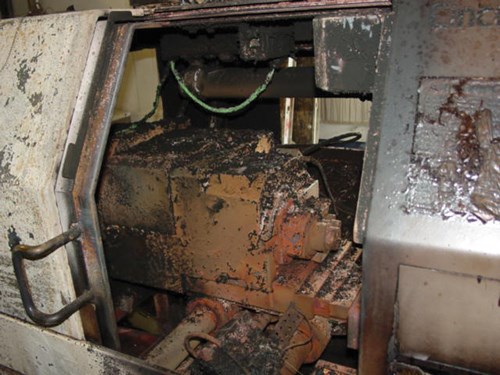
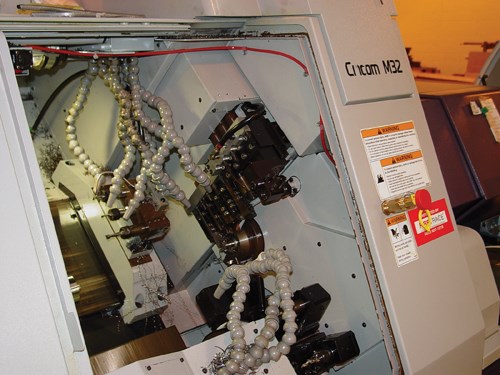












.png;maxWidth=300;quality=90)

.png;maxWidth=300;quality=90)







